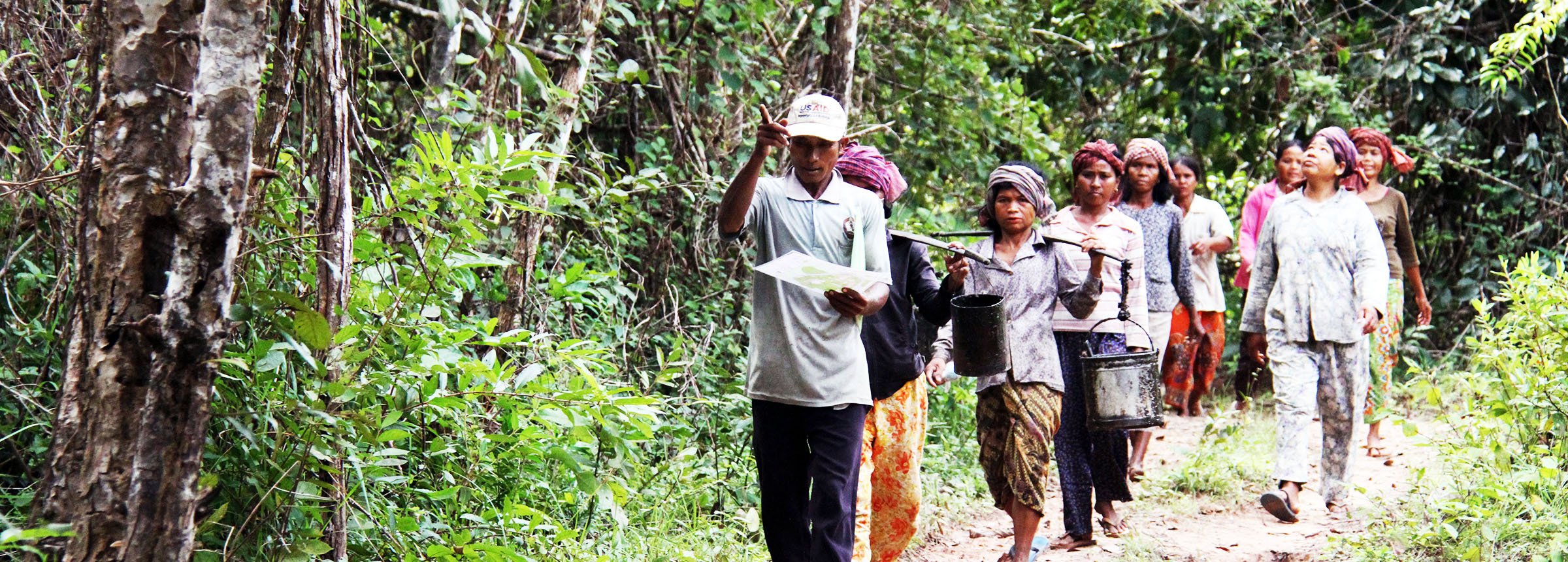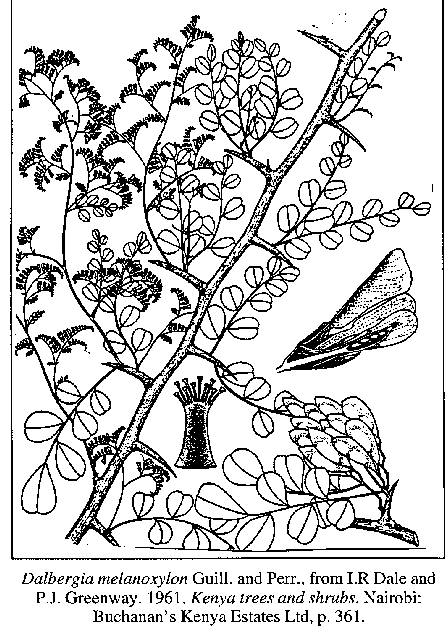
Dalbergia melanoxylon: valuable wood from a neglected tree
NFTA 93-05, September 1993
A quick guide to useful nitrogen fixing trees from around the world
Dalbergia melanoxylon produces one of the finest timbers in the world. Known in Tanzania as African ironwood, African ebony, mpingo, poyi or mugembe (Brenan and Greenway, 1949; Gillet et al., 1971; Noad and Birnie, 1989), round logs of this species fetch up to US$18,000/m3. Yet the trees are seldom planted and little is known about their silviculture.
 Botany
Botany
Dalbergia melanoxylon Guill. & Perr. (Leguminosae subfamily Papilionoidae) is a small, heavily branched tree, typically 4.5 to 7.5 m tall but occasionally reaching 15 m. The bole is fluted with high narrow ribs separated by deep indentations. Bole length occasionally reaches up to 3.6 m, but normally ranges from 1.2 to 1.8 m. Average diameter at breast height (dbh) at maturity is less than 38 cm, although trees have been found with a dbh of more than 60 cm. The bark is pale gray to grayish-brown, papery, fairly smooth, and flaking in long narrow strips (Bryce, 1967). The stems are often crooked.
Branchlets are clustered at the nodes.Some grow out, while others are short and spine tipped.
They are covered at first with short crisp hairs, and are usually glabrous. Leaves are alternate, pinnately compound and 6 to 22 cm long. The fragrant white flowers are 6 to 9 cm long, occurring in dense clusters. There are usually nine stamens, united or variously divided. Pods are elliptic oblong or irregularly oblong, bluntly pointed, flat and thin. They range from 3 to 7 cm long and 0.8 to 1.4 cm wide. They tend to be papery, glabrous, and laxly and rather diffusely veined, with one or two seeds.
Ecology
Dalbergia melanoxylon grows under a wide range of conditions including semi-arid, subhumid and tropical lowland areas. It is often found on dry, rocky sites at elevations from sea level to 1200 m, but is most frequent in the mixed deciduous forests and savannas of the coastal region. The mean minimum temperature in its native range is 18°C and the maximum is 35°C, with no frost. Annual rainfall averages 700 to 1200 mm, often distributed in a bimodal pattern of three to six months. Soils vary from loamy sands to clayey vertisols (“black cotton soils”). The species is water and light demanding; it is common near water and will not regenerate under heavy cover. Mature trees are fire tolerant.
Distribution
Dalbergia melanoxylon is widely distributed in Africa, from Senegal across to Sudan, Eritrea and northern Ethiopia, Uganda and Kenya. To the south, it ranges from Angola to Zambia, Tanzania and Mozambique, as far south as the Transvaal (Gillett et al., 1971; Redhead and Temu, 1981).
Uses
Traditional uses include fuelwood and charcoal, as well as pestles, combs, knife shafts, cups and farming implements.
Timber. The sapwood is white or yellowish-white, often 12cm wide, and sharply differentiated. The heartwood is purplish black, sometimes darker towards the outside, with light streaks and not always uniform in color. The timber is slightly oily, exceptionally hard and heavy, brittle and somewhat fissile. The heartwood is extremely durable (specific gravity not yet determined) and resistant to all forms of bio-deterioration. The sapwood, however, is susceptible to fungal or insect attack (Bryce, 1967). The dry wood is difficult to saw or plane. It blunts saws and cutters and cannot be nailed or screwed without drilling. It is, however, the finest of all turnery timbers, cutting exactly and finishing to a brilliantly polished, lustrous surface, dry and cold to the touch.
Fuelwood. The calorific value of the sapwood and heartwood is more than 49,000 Kcal/kg. Heat generation is so high that fires of D. melanoxylon have been reported to melt cooking utensils.
Specialized uses. The wood of D. melanoxylon is used in carving, turnery and marquetry to produce sculptures, musical instruments, ornaments, inlays, chess pieces, walking sticks, bearings and many other products. The main industrial use, long supporting an export trade from East Africa and Mozambique, is the manufacture of musical instruments, especially woodwinds. With its high density and fine texture, D. melanoxylon wood produces a beautiful musical tone. It is stable, stands up to metal- working processes, and takes an excellent finish (Bryce, 1967).
The roots are used in traditional medicines to treat abdominal pain, diarrhea and syphilis. The smoke is inhaled to treat headaches and bronchitis. The pods and leaves can be used as animal fodder.
Silviculture
Seed treatment. Seeds (about 42,000/kg) generally remain viable for only a few months, although viability could probably be increased by storage in sealed containers. Seed extracted from pods germinates readily without treatment. However, few seedlings attain maturity under natural conditions due to fire and drought (Mugasha, 1978).
Establishment. In Tanzania, D. melanoxylon has not yet been planted extensively. Experimental work suggests that survival and growth are improved by planting two-year-old stumps that are 14 cm long, comprising 12 cm of root and 2 cm of shoot. These should be planted in the early or middle rainy season, followed by intensive weeding. Potted seedlings may also be used, but they tend to grow more slowly (Mugasha, 1983). When seedlings are raised in pots, frequent root pruning is mandatory. Delayed pruning leads to seedling shock. Advanced plant-production techniques, such as tissue culture or use of growth hormones, have not been tested.
Management. Field trials are currently exploring suitable spacing for D. melanoxylon plantations. An initial spacing of 2 x 2 m results in good branching characteristics, while later thinning improves growth. Stem form is improved by raising the trees under medium shade provided by Pinus caribaea Morelet (Nshubemuki, 1983).
Thorough weeding is important at the initial phase of establishment. After 7.5 years, trees planted early in the rainy season on thoroughly weeded plots averaged about 30% taller than trees planted at the same time but only lightly weeded. Trees planted in the middle of the rainy season and thoroughly weeded were taller still–about 45% taller than those planted at the beginning of the rains and lightly weeded (Mugasha, 1983). Intensive weeding is crucial until root-collar diameters measure about 5 cm. Alternatively, the area around the trees should beslashed until root-collar diameters measure 8 to 10 cm. The species is extremely slow growing: trees obtain timber size in 70 to 100 years. Studies on mycorrhizal associations have not been initiated.
Pests and diseases. Heart rot is observed on some logs, apparently associated with fungal infection following fire damage. Small game may feed on young shoots and leaves.
Limitations
Dalbergia melanoxylon is not gregarious and may be difficult to establish in pure plantations. Rapid loss of seed viability might also make it difficult to establish plantations in new areas. Difficulties in working the wood call for specialized techniques, perhaps not feasible for cottage industries.
Logs are almost invariably defective and the wastage is considerable in conversion to top-grade dimension stock. End checks appear soon after felling and star shakes develop unless end coatings are applied immediately. Seasoning may take as long as two to three years after pieces are rough sawn.
Future research needs
Dalbergia melanoxylon occurs in three of the four drainag basins found in Tanzania. Observed differences in growth habits suggest the existence of clinal variation resulting from genetic, topographic and ecological influences. Selections for characters such as fast growth, wood quality, volume production and stem straightness have considerable potential. Studies of provenance variation related to end use should form the basis for in-situ and ex-situ conservation.
Research would be useful on improved methods to increase seed viability and shorten the seasoning period. Symbiotic relationships also need to be explored and quantified. Hybridization with related species, such as D. sissoo, should be initiated.
References
Brenan, J.P.M. and Greenway, P.J. 1949. Check lists of the forest trees and shrubs of the British Empire. Part 5: Tanganyika Territory. Oxford (UK): Imperial Forestry Institute, p. 418.
Bryce, J.M. 1967. The commercial timbers of Tanzania. Moshi (Tanzania): Tanzania Forest Division, Utilization Section, p. 139.
Gillet, J.B., Polhill, R.M. and Verdourt, B. 1971. Flora of tropical East Africa. Part 3: Leguminosae, sub-family Papilionoidae.
Mugasha, A.G. 1978. Tanzania natural forests’ silvicultural research: review report. Tanzania Silviculture Technical Note (New Series) 39, p. 41.
Mugasha, A.G. 1978. The effects of planting season, different planting materials and weeding methods on early performance of Dalbergia melanoxylon at Kwamarukanga, Korogwe, Tanzania. Tanzania Silviculture Research Note 43, p. 14.
Noad, T. and Birnie, A. 1989. Trees of Kenya. Nairobi: General Printers, p. 219.
Nshubemuki, L. 1993. Recent research progress in the silviculture of Dalbergia melanoxylon in Tanzania. Paper presented to the International Workshop on Dalbergia species, 31 May to 4 June, Hetauda, Nepal.
Redhead, J.F. and Temu, A.B. 1981. Valued timber but neglected tree: mpingo (Dalbergia melanoxylon). Tanzania Association of Foresters Newsletter. 2:8–9.
Tack, C.H. 1962. Nomenclature of East African timbers. Nairobi: East African Timber Advisory Board, p. 16.
Financial support for this NFT Highlight was provided by the United States Forest Service Forestry Support Program (USFS/FSP) and the Danish International Development Agency
(DANIDA).
This issue was prepared by Dr. Ladislaus Nshubemuki, Director of Forest Production Research,
Tanzania Forestry Research Institute, P.O. Box 1854, Morogoro, Tanzania.
A publication of the Forest, Farm, and Community Tree Network
